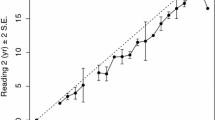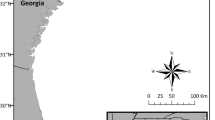Abstract
Age and growth estimates of shortfin mako sharks Isurus oxyrinchus from the western South Atlantic Ocean were obtained through the analysis of vertebral sections of 245 specimens (126 females, 116 males and 3 with undetermined sex), ranging in size from 78 to 330 cm fork length (FL), using a flexible growth model (Schnute model) and a Bayesian approach. A significant linear relationship was found between FL and vertebral radius for sexes combined. Marginal increment analyses were inconclusive about periodicity of growth band deposition and an annual periodicity was assumed to make age estimations. Specimens were estimated to be between 0 and 28 years of age. The Schnute model provided a good description of the individual growth for both sexes up to 15 years of age. Shortfin mako growth during the first year of life was 33.9 cm (ICr95% = 19.9–40.8) for females and 30.5 cm (ICr95% = 25.6–35.4) for males. Until approximately 15 years of age, both sexes showed similar growth and reached ~217 cm FL. Sigmoid shaped growth curves obtained for both sexes indicated a change in the growth pattern close to 7 years of age. Inconclusive results about periodicity of growth band deposition in the study area make necessary the application of more robust validation techniques in the future. Meanwhile, a precautionary approach that assumes an annual deposition pattern in the western South Atlantic can be used for the assessment and management of stocks of this species, characterized by low fecundity and late maturity.








Similar content being viewed by others
References
Araya M, Cubillos LA (2006) Evidence of two-phase growth in elasmobranchs. Environ Biol Fishes 77:293–300
Ardizzone D, Cailliet GM, Natanson LJ, Andrews AH, Kerrn LA, Brown TA (2006) Application of bomb radiocarbon chronologies to shortfin mako (Isurus oxyrinchus) age validation. Environ Biol Fishes 77:355–366
Beamish RJ, Fournier DA (1981) A method for comparing the precision of a set of age determinations. Can J Fish Aquat Sci 38:982–983
Bigelow HB, Schroeder WC (1948) Sharks. In: Tee-Van J (ed) Fishes of the Western North Atlantic. Part One. New haven, sears found. Mar. Res. Yale University, pp 59–546
Bishop SDH, Francis MP, Duffy C, Montgomery JC (2006) Age, growth, maturity, longevity and natural mortality of the shortfin mako (Isurus oxyrinchus) in New Zealand waters. Mar Freshw Res 57:143–154
Brothers EB (1983) Summary of round table discussions on age validation. In: Prince ED, Pulos M (eds) Proceedings of the international workshop on age determination of oceanic pelagic fishes: tunas, billfishes and sharks. NOAA Technical Report NMFS 8:35–44
Cailliet GM, Martin LK, Harvey JT, Kusher D, Welden BA (1983) Preliminary studies on the age and growth of blue (Prionace glauca), common thresher (Alopias vulpinus), and shortfin mako (Isurus oxyrinchus) sharks from California waters. In: Prince ED, Pulos M (eds) Proceedings of the international workshop on age determination of oceanic pelagic fishes: tunas, billfishes and sharks. NOAA Technical Report NMFS 8:179–188
Campana SE (2001) Accuracy, precision and quality control in age determination, including a review of the use and abuse of age validation methods. J Fish Biol 59:197–242
Campana SE, Annand MC, Mc Millan JI (1995) Graphical and statistical methods for determining the consistency of age determinations. Trans Am Fish Soc 124:131–138
Campana SE, Natanson LJ, Myklevoll S (2002) Bomb dating and age determination of large pelagic sharks. Can J Fish Aquat Sci 59:450–455
Campana SE, Marks L, Joyce W (2005) The biology and fishery of shortfin mako sharks (Isurus oxyrinchus) in Atlantic Canadian waters. Fish Res 73:341–352
Carvalho F, Hazin H, Hazin FHV, Wor C, Murie D, Travassos P, Burgess G (2009) Catch trends of blue and mako sharks caught by Brazilian longliners in the southwestern Atlantic Ocean (1978–2007). Col Vol Sci Pap ICCAT 64(5):1717–1733
Casey JG, Pratt HL Jr, Stillwell CE (1985) Age and growth of the sandbar shark (Carcharhinus plumbeus) from the western North Atlantic. Can J Fish Aquat Sci 42:963–975
Casselman JM (1983) Age and growth assessment of fish from their calcified structures-techniques and tools. In: Prince ED, Pulos M (eds) Proceedings of the international workshop on age determination of oceanic pelagic fishes: tunas, billfishes and sharks. NOAA Technical Report NMFS 8:1–17
Cerna F, Licandeo R (2009) Age and growth of the shortfin mako (Isurus oxyrinchus) in the south-eastern Pacific off Chile. Mar Freshw Res 60:394–403
Clarke SC, Mc Allister MK, Milner- Gulland EJ, Kirkwood GP, Michielsens CGJ, Agnew DJ, Pikitch EK, Nakano H, Shivji MS (2006) Global estimates of shark catches using trade records from commercial markets. Ecol Lett 9:1115–1126
Compagno LJV (2001) Sharks of the world. An annotated and illustrated catalogue of shark species known to date. Volume 2. Bullhead, mackerel and carpet sharks (Heterodontiformes, Lamniformes and Orectolobiformes). FAO Species Catalogue for Fishery Purposes. No. 1, Vol. 2. FAO, Rome, 269pp
Cortés E, Arocha F, Beerkircher L, Carvalho F, Domingo A, Heupel M, Holtzhausen H, Santos MN, Ribera M, Simpfendorfer C (2010) Ecological risk assessment of pelagic sharks caught in Atlantic pelagic longline fisheries. Aquat Living Resour 22:1–10
Costa FES, Braga FMS, Arfelli CA, Amorim AF (2002) Aspects of the reproductive biology of the shortfin mako, Isurus oxyrinchus (Elasmobranchii Lamnidae), in the southeastern region of Brazil. Braz J Biol 62(2):239–248
Domingo A, Mora O, Cornes M (2002) Evolución de las capturas de elasmobranquios pelágicos en la pesquería de atunes de Uruguay, con énfasis en los tiburones azul (Prionace glauca), moro (Isurus oxyrinchus) y porbeagle (Lamna nasus). Col Vol Sci Pap ICCAT 54(4):1406–1420
Francis MP, Duffy C (2005) Length at maturity in three pelagic sharks (Lamna nasus, Isurus oxyrinchus and Prionace glauca) from New Zealand. Fish Bull 103:489–500
Francis MP, Campana SE, Jones CM (2007) Age under-estimation in New Zealand porbeagle sharks (Lamna nasus): is there an upper limit to ages that can be determined from shark vertebrae? Mar Freshw Res 58:10–23
Goldman KJ, Cailliet GM, Andrews AH, Natanson LJ (2012) Assessing the age and growth of chondrichthyan fishes. In: Carrier JC, Musick JA, Heithaus MR (eds) Biology of sharks and their relatives, 2nd edn. CRC Press, Boca Raton, pp 423–452
ICCAT (2012) Shortfin mako stock assessment and ecological risk assessment meeting. Meeting report, Olhão
Joung SJ, Hsu HH (2005) Reproduction and embryonic development of the shortfin mako, Isurus oxyrinchus Rafinesque, 1810, in the Northwestern Pacific. Zool Stud 44(4):487–496
Katsanevakis S, Maravelias CD (2008) Modelling fish growth: multi-model inference as a better alternative to a priori using von Bertalanffy equation. Fish Fish 9:178–187
Kinas PG, Andrade HA (2010) Introdução à análise bayesiana (com R). Mais Q Nada, Porto Alegre
Kohler NE, Turner PA (2001) Shark tagging: a review of conventional methods and studies. Environ Biol Fish 60:191–223
Lessa R, Santana FM, Duarte-Neto P (2006) A critical appraisal of marginal increment analysis for assessing temporal periodicity in band formation among tropical sharks. Environ Biol Fish 77:309–315
Mc Allister MK, Hill SL, Agnew DJ, Kirkwood GP, Beddington JR (2004) A Bayesian hierarchical formulation of the De Lury stock assessment model for abundance estimation of Falkland Islands’ squid (Loligo gahi). Can J Fish Aquat Sci 61:1048–1059
Mejuto J, García-Cortés B, Ramos-Cartelle A, De la Serna JM (2009) Standardized catch rates for the blue shark (Prionace glauca) and shortfin mako (Isurus oxyrinchus) caught by the Spanish surface longline fleet in the Atlantic ocean during the period 1990–2007. Col Vol Sci Pap ICCAT 64(5):1509–1521
Mollet HF, Cliff G, Pratt HL, Stevens JD (2000) Reproductive biology of the female shortfin mako, Isurus oxyrinchus Rafinesque, 1810, with comments on the embryonic development of lamnoids. Fish Bull 98:299–318
Montealegre-Quijano S, Chaves V, Vooren CM, Soto JMR (2007) Sobre a ocorrência, distribuição e abundância de tubarões Lamniformes no ambiente oceânico do sul do Brasil e águas internacionais adjacentes. Bol Soc Brasil Ictiol 86:6–8
Natanson LJ, Casey JG, Kohler NE (1995) Age and growth estimates for the dusky shark, Carcharhinus obscurus, in the western North Atlantic Ocean. Fish Bull 93:116–126
Natanson LJ, Kohler NE, Ardizzone D, Cailliet GM, Wintner SP, Mollet HF (2006) Validated age and growth estimates for the shortfin mako, Isurus oxyrinchus, in the North Atlantic Ocean. Environ Biol Fish 77:367–383
Pons M, Domingo A (2009) Actualización de la estandarización de la CPUE del tiburón moro (Isurus oxyrinchus) capturado por la flota de palangre pelágico de Uruguay (1982–2007). Col Vol Sci Pap ICCAT 64(5):1623–1631
Pratt HL Jr, Casey JG (1983) Age and growth of the shortfin mako, Isurus oxyrinchus, using four methods. Can J Fish Aquat Sci 40:1944–1957
R Core Team (2012) R: a language and environment for statistical computing. R Foundation for Statistical Computing, Vienna, Austria. ISBN 3-900051-07-0, URL http://www.R-project.org/
Ribot-Carballal MC, Galván-Magaña F, Quiñónez-Velázquez C (2005) Age and growth of the shortfin mako shark, Isurus oxyrinchus, from the western coast of Baja California Sur, Mexico. Fish Res 76:14–21
Ricker WE (1975) Computation and interpretation of biological statistics of fish populations. Bull Fish Res Board Can 191:1–382
Rubin DB (1988) Using the SIR algorithm to simulate posterior distributions. In: Bernardo JM, De Groot MH, Lindley DV, Smith AF (eds) Bayesian statistics 3: proceedings of the third valencia international meeting. Clarendon, Oxford
Santana FM, Lessa R (2004) Age determination and growth of the night shark (Carcharhinus signatus) off the northeastern Brazilian coast. Fish Bull 102:156–167
Schnute J (1981) A versatile growth model with statistically stable parameters. Can J Fish Aquat Sci 38:1128–1140
Semba Y, Nakano H, Aoki I (2009) Age and growth analysis of the shortfin mako, Isurus oxyrinchus, in the western and central North Pacific Ocean. Environ Biol Fish 84:377–391
Semba Y, Aoki I, Yokawa K (2011) Size at maturity and reproductive traits of shortfin mako, Isurus oxyrinchus, in the western and central North Pacific. Mar Freshw Res 62:20–29
Sparre PE, Venema SC (1995) Introducción a la evaluación de recursos pesqueros tropicales, Parte 1. Manual FAO Documento Técnico de Pesca, 306/1. Valparaiso, Chile
Stevens JD (1983) Observations on reproduction in the shortfin mako Isurus oxyrinchus. Copeia 1:126–130
Sturtz S, Ligges U, Gelman A (2005) R2WinBUGS: a package for running WinBUGS from R. J Stat Softw 12(3):1–16
Thomas A, O’Hara B, Ligges U, Sturtz S (2006) Making bugs open. Rep Newsmag 6(1):12–17
von Bertalanffy L (1938) A quantitative theory of organic growth. Hum Biol 10:181–213
Wells RJD, Smith SE, Kohin S, Freund E, Spear N, Ramon DA (2013) Age validation of juvenile shortfin mako (Isurus oxyrinchus) tagged and marked with oxytetracycline off southern California. Fish Bull 111:147–160
West M (1993) Approximating posterior distributions by mixtures. J R Stat Soc B 55:409–422
Wood AD, Collie JS, Kohler NE (2007) Estimating survival of the shortfin mako Isurus oxyrinchus (Rafinesque) in the north-west Atlantic from tag-recapture data. J Fish Biol 71:1679–1695
Acknowledgments
We are grateful to the Brazilian Conselho Nacional de Desenvolvimento Científico e Tecnológico (CNPq) for the scholarship provided to the first author. We thank the Oceanographic Museum Univali and its Program of Life Resources Survey at the Rio Grande Rise, in the person of Jules M. R. Soto for logistic support of the field work. We are grateful to fishery firm Kowalsky Ind. e Com. Ltda. for permission to embark in the fishing vessels Yamaya III and Macedo IV, and especially to Captain Miranda and his crew members for their generous cooperation at sea. We also thank scientific observers who collected additional vertebrae and F. Mas for its contribution in vertebral processing. Thanks to the Laboratório de Mamíferos Marinhos (Instituto de Oceanografía, FURG) and Laboratorio de Edad y Crecimiento (DINARA), especially Inés Lorenzo, for logistical support provided for vertebrae processing. Special thanks to Gregor Cailliet, Jorge Pablo Castello and Manuel Haimovici for their valuable suggestions and comments to the manuscript. This research is part of the M.Sc. Dissertation written by the first author under the guidance of the second and last authors.
Author information
Authors and Affiliations
Corresponding author
Rights and permissions
About this article
Cite this article
Doño, F., Montealegre-Quijano, S., Domingo, A. et al. Bayesian age and growth analysis of the shortfin mako shark Isurus oxyrinchus in the Western South Atlantic Ocean using a flexible model. Environ Biol Fish 98, 517–533 (2015). https://doi.org/10.1007/s10641-014-0284-1
Received:
Accepted:
Published:
Issue Date:
DOI: https://doi.org/10.1007/s10641-014-0284-1




